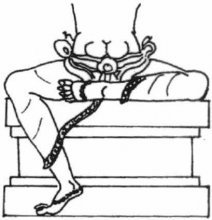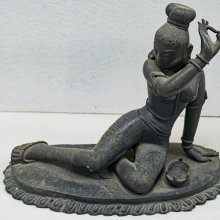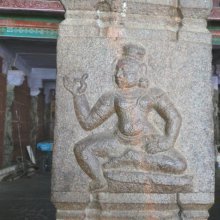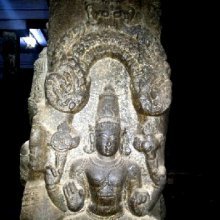Sukhasana, Sukha-asana, Sukhāsana: 14 definitions
Introduction:
Sukhasana means something in Hinduism, Sanskrit, Jainism, Prakrit, the history of ancient India, Marathi. If you want to know the exact meaning, history, etymology or English translation of this term then check out the descriptions on this page. Add your comment or reference to a book if you want to contribute to this summary article.
Images (photo gallery)
(+12 more images available)
In Hinduism
Yoga (school of philosophy)
Source: Wisdom Library: YogaSukhāsana (सुखासन, “comfortable posture”) is a Sanskrit word referring to a type of posture (āsana) used in Yoga. It is composed of the words sukha (comfortable) and āsana (posture).
Source: archive.org: Yoga Tradition of the Mysore PalaceSukhāsana (सुखासन) is a type of standing posture (āsana), according to verse 75 of the Śrītattvanidhi.—Accordingly, “Place the right hand on the right knee and the left hand on the left knee. Do the saccid-mudrā. Keep the eyes half closed. This is sukhāsana, the āsana of happiness”.
The 19th-century Śrītattvanidhi is a sanskrit treatise describing 80 primary āsanas, or ‘posture’ (e.g., sukha-āsana) and several additional ones.
Source: ORA: Amanaska (king of all yogas): A Critical Edition and Annotated Translation by Jason BirchSukhāsana (सुखासन) refers to a “comfortable seat”, according to the Amanaska Yoga treatise dealing with meditation, absorption, yogic powers and liberation.—Accordingly, as Īśvara says to Vāmadeva: “[...] [Now], I will teach the practice of that, which produces absorption. [...] Sitting evenly on a comfortable seat (sukhāsana), one should accomplish the practice of [eliminating] the [lower] Tattvas. Through constant practice, [the Yogin] should make manifest the highest reality. [...]”.

Yoga is originally considered a branch of Hindu philosophy (astika), but both ancient and modern Yoga combine the physical, mental and spiritual. Yoga teaches various physical techniques also known as āsanas (postures), used for various purposes (eg., meditation, contemplation, relaxation).
Shaivism (Shaiva philosophy)
Source: Shodhganga: Iconographical representations of Śiva1) Sukhāsana (सुखासन) or Sukhāsanamūrti refers to one of the twenty-three forms (mūrti) of Śiva mentioned in the Pūrvakāmikāgama (pratimālakṣaṇavidhi-paṭala): first and foremost among the Mūlāgama. The forms of Śiva (e.g., Sukhāsana) are established through a process known as Sādākhya, described as a five-fold process of creation.
2) Sukhāsana is also listed among the eighteen forms (mūrti) of Śiva mentioned in the Kāraṇāgama (pratimālakṣaṇavidhi-paṭala): the fourth among the Siddhāntaśaivāgamas.
3) Sukhāsana is also listed among the eight forms (mūrti) of Śiva mentioned in the Rauravāgama: the sixteenth among the Siddhāntaśaivāgamas.
4) Sukhāsana is also listed among the twelve forms (mūrti) of Śiva mentioned in the Suprabhedāgama: the tenth among the Siddhāntaśaivāgamas.
5) Sukhāsana is also listed among the ten forms (mūrti) of Śiva mentioned in the Ajitāgama (under the Maheśvararūpa heading): the fifth among the Siddhāntaśaivāgamas.
6) Sukhāsana is also listed among the sixteen forms (mūrti) of Śiva mentioned in the Dīptāgama: the sixth among the Siddhāntaśaivāgamas.
7) Sukhāsana is also listed among the eighteen forms (mūrti) of Śiva mentioned in the Śilparatna (twenty-second adhyāya): a technical treatise by Śrīkumāra on Śilpaśāstra.

Shaiva (शैव, śaiva) or Shaivism (śaivism) represents a tradition of Hinduism worshiping Shiva as the supreme being. Closely related to Shaktism, Shaiva literature includes a range of scriptures, including Tantras, while the root of this tradition may be traced back to the ancient Vedas.
Shilpashastra (iconography)
Source: Shodhganga: The significance of the mūla-beras (śilpa)Sukhāsana (सुखासन) refers to a type of Āsana (sitting poses), according to Ganapati Sthapati in his text Ciṟpa Cennūl, as defined according to texts dealing with śilpa (arts and crafs), known as śilpaśāstras.—The body is held erect without shift or curve to any side, with one leg folded flat and the other hanging in a very reposeful manner; the hands are held together in equilibrium. This is called sukhāsana. This posture is usually favoured for Śiva and Viṣṇu images which are consecrated separately (without supporting figures) and are called Sukhāsana Viṣṇu or Sukhāsana Śiva.
Sukhāsana is where the body is held erect without shift or curve to any side, with one leg folded flat and the other hanging in a very reposeful manner and the hands held together in equilibrium. The sukhāsana posture is usually favoured for Śiva and Viṣṇu images which are consecrated separately (without supporting figures) and are called Sukhāsana Viṣṇu or Sukhāsana Śiva. Subrahmanya is also found in sukhāsana posture.
Source: Shodhganga: Vaisnava Agamas And Visnu ImagesSukhāsana (सुखासन) refers to one of the various posture (āsanas) defined in treatises such as the Pāñcarātra, Pādmasaṃhitā and Vaikhānasa-āgamas, extensively dealing with the technical features of temple art, iconography and architecture in Vaishnavism.—Sukhāsana, signifying any comfortable seated position is common in the icons of high grade. In this the divinity is depicted in sitting posture on a pedestal (pīṭha) with one of the legs resting flat on the seat while another is let down.
The Sukhāsana pose may be taken as Rājalīlāsana or Lalitāsana with one leg resting flat on the seat and another knee is raised upwards from it and the right arm, as daṇḍa-hasta or gaja-hasta, is stretched out and is placed on the raised knee.
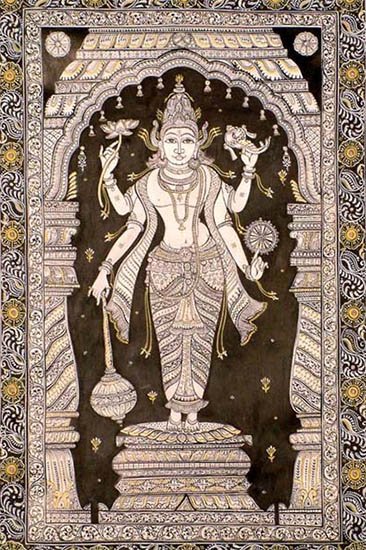
Shilpashastra (शिल्पशास्त्र, śilpaśāstra) represents the ancient Indian science (shastra) of creative arts (shilpa) such as sculpture, iconography and painting. Closely related to Vastushastra (architecture), they often share the same literature.
Purana and Itihasa (epic history)
Source: archive.org: Shiva Purana - English TranslationSukhāsana (सुखासन) refers to a “splendid seat”, according to the Śivapurāṇa 2.3.23 (“Attempt of Himavat to dissuade Pārvatī”).—Accordingly, after the Gods and others spoke to Brahmā: “On hearing their words I remembered Śiva and pondered over everything. I realised that the universe was scorched as a result of Pārvatī’s penance. Accompanied by them I hastened respectfully to the milk ocean to inform Viṣṇu about it. Reaching that place along with the gods, I saw Viṣṇu shining lustrously on a splendid seat [i.e., sukhāsana]. Bowing to and eulogising him with palms joined in reverence I spoke:—[...]”.

The Purana (पुराण, purāṇas) refers to Sanskrit literature preserving ancient India’s vast cultural history, including historical legends, religious ceremonies, various arts and sciences. The eighteen mahapuranas total over 400,000 shlokas (metrical couplets) and date to at least several centuries BCE.
In Jainism
General definition (in Jainism)
Source: The University of Sydney: A study of the Twelve ReflectionsSukhāsana (सुखासन) refers to the “pleasant posture”, according to the 11th century Jñānārṇava, a treatise on Jain Yoga in roughly 2200 Sanskrit verses composed by Śubhacandra.—Accordingly, “On a flat piece of wood or stone, on the ground or on sandy soil, the wise [person] should adopt a stable posture for the accomplishment of absorption. Thus, sitting cross-legged, sitting half cross-legged, thunderbolt, hero posture and the previously mentioned pleasant and lotus (sukhāsana—sukhāravindapūrve) [postures] as well as abandonment of the body is highly thought of. [...]”.

Jainism is an Indian religion of Dharma whose doctrine revolves around harmlessness (ahimsa) towards every living being. The two major branches (Digambara and Svetambara) of Jainism stimulate self-control (or, shramana, ‘self-reliance’) and spiritual development through a path of peace for the soul to progess to the ultimate goal.
India history and geography
Source: Cologne Digital Sanskrit Dictionaries: Indian Epigraphical GlossarySukha-asana.—(Ind. Ant., Vol. IX, p. 95), translated as ‘a palanquin’; enumerated as one of the five prasādas granted by a king to a subordinate. Cf. pañcāṅga-prasāda. Note: sukha-asana is defined in the “Indian epigraphical glossary” as it can be found on ancient inscriptions commonly written in Sanskrit, Prakrit or Dravidian languages.

The history of India traces the identification of countries, villages, towns and other regions of India, as well as mythology, zoology, royal dynasties, rulers, tribes, local festivities and traditions and regional languages. Ancient India enjoyed religious freedom and encourages the path of Dharma, a concept common to Buddhism, Hinduism, and Jainism.
Languages of India and abroad
Marathi-English dictionary
Source: DDSA: The Molesworth Marathi and English Dictionarysukhāsana (सुखासन).—n (S) A festal couch; a chair or seat of enjoyment or ease. Ex. rāyēṃ baisavilā sukhā- sanīṃ ||; also sapta śatēṃ daśarathayuvatī || tyāhī rāmalagna pāhōṃ yēti || sukhāsanīṃ baisōni nighati ||. 2 A commodious or comfortable vehicle or carriage; an easy coach or litter; an easy seat in general. 3 A chair, not unlike a Tom-John, granted originally by the king to certain persons as a mark of honor or favor.
Marathi is an Indo-European language having over 70 million native speakers people in (predominantly) Maharashtra India. Marathi, like many other Indo-Aryan languages, evolved from early forms of Prakrit, which itself is a subset of Sanskrit, one of the most ancient languages of the world.
Sanskrit dictionary
Source: DDSA: The practical Sanskrit-English dictionarySukhāsana (सुखासन).—a comfortable seat.
Derivable forms: sukhāsanam (सुखासनम्).
Sukhāsana is a Sanskrit compound consisting of the terms sukha and āsana (आसन).
Source: Cologne Digital Sanskrit Dictionaries: Monier-Williams Sanskrit-English DictionarySukhāsana (सुखासन):—[from sukha > sukh] n. a comfortable seat, [Siṃhāsana-dvātriṃśikā or vikramāditya-caritra, jaina recension]
Sanskrit, also spelled संस्कृतम् (saṃskṛtam), is an ancient language of India commonly seen as the grandmother of the Indo-European language family (even English!). Closely allied with Prakrit and Pali, Sanskrit is more exhaustive in both grammar and terms and has the most extensive collection of literature in the world, greatly surpassing its sister-languages Greek and Latin.
Kannada-English dictionary
Source: Alar: Kannada-English corpusSukhāsana (ಸುಖಾಸನ):—
1) [noun] a comfortable, deluxe seat.
2) [noun] a chair with supports at the sides for one’s arms or elbows; an arm-chair.
3) [noun] (yoga.) a comfortable sitting position.
Kannada is a Dravidian language (as opposed to the Indo-European language family) mainly spoken in the southwestern region of India.
See also (Relevant definitions)
Partial matches: Sukha, Asana.
Starts with: Sukhasanamurti.
Full-text (+18): Sukhasanamurti, Cukatanam, Comfortable seat, Porramarai, Someshvara, Karakatu Perumal, Shrirama, Subrahmaṇya, Siddhar, Murugan, Rahu, Pancanga-prasada, Candikeshvar, Candikeshvara, Aindra, Solaimalai Naciyar, Candikeshvari, Mrigayatra, Camunda, Rama.
Relevant text
Search found 10 books and stories containing Sukhasana, Sukha-asana, Sukhāsana, Sukha-āsana, Sukhasava, Sukhāsava; (plurals include: Sukhasanas, asanas, Sukhāsanas, āsanas, Sukhasavas, Sukhāsavas). You can also click to the full overview containing English textual excerpts. Below are direct links for the most relevant articles:
Yogadrstisamuccaya of Haribhadra Suri (Study) (by Riddhi J. Shah)
Chapter 4.3b - Āsana (posture) < [Chapter 4 - The Eight Yogadṛṣṭis and the nature of a Liberated Soul]
Kashyapa Shilpa-shastra (study) (by K. Vidyuta)
7. Favourable Directions for Installing the Śiva Mūrtis < [Chapter 3 - Prākāra Lakṣaṇa]
Brihad Bhagavatamrita (commentary) (by Śrī Śrīmad Bhaktivedānta Nārāyana Gosvāmī Mahārāja)
Verse 1.4.45 < [Chapter 4 - Bhakta (the devotee)]
Sripura (Archaeological Survey) (by Bikash Chandra Pradhan)
Stone Images (3): Vaisnava Images < [Chapter 3 - Sculptural Programme]
Middle Chola Temples (by S. R. Balasubrahmanyam)
Temples in Tirukkalar < [Chapter II - Temples of Rajaraja I’s Time]
Temples in Tiruvalisvaram < [Chapter II - Temples of Rajaraja I’s Time]
4. Icons set up By Rajaraja I’s Officers and others < [Tanjavur/Thanjavur (Rajarajesvaram temple)]
Early Chola Temples (by S. R. Balasubrahmanyam)
Bronze, group 1: Late Pallava and Early Chola—Age of Vijayalaya (a.d. 785-871) < [Chapter XI - Sculpture]
